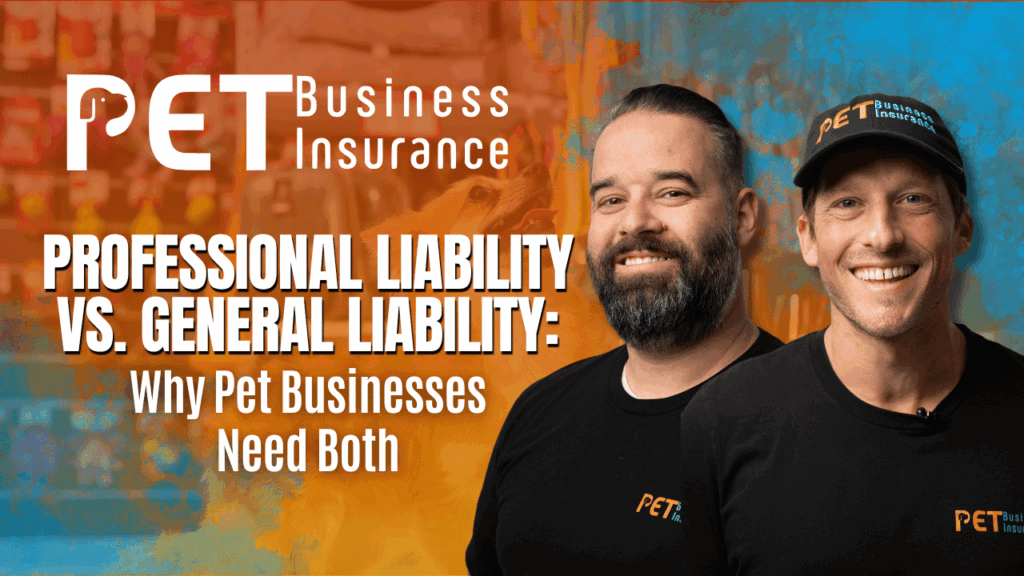
If you own a pet business, you already know accidents happen—often when you least expect them. But what happens when those accidents turn into lawsuits, injured animals, or damaged property? Can you afford the out-of-pocket costs? Will your current insurance even cover the claim?
What most pet business owners don’t realize is this: Not all insurance policies cover the same risks. You may be protected if someone slips in your grooming salon—but not if a client sues you for using a product that caused their show dog to lose value.
That’s where general liability and professional liability come into play.
In this article, we’ll clearly explain:
- The key differences between general and professional liability insurance
- Real-world claim scenarios from pet sitters, groomers, trainers, and daycare providers
- Why having both types of insurance is essential—no matter your business model
What Is General Liability Insurance and What Does It Cover?
General liability insurance covers physical incidents involving third parties—typically bodily injury or property damage that occurs during the course of your business operations.
Common Scenarios Where General Liability Insurance Protects You
Bodily injury: A dog gets loose during a training session and knocks over a bystander who breaks their wrist.
Property damage: A pet in your care damages a client’s antique rug.
Reputational harm: A dispute escalates into a lawsuit claiming you posted false information online.
If it involves physical harm to people or damage to their property, general liability is your safety net.
A real-world example: PROfur reports a dog walker was sued after a dog in their care knocked over a child, causing a concussion. The lawsuit cost over $43,000 in damages and legal fees.
What Is Professional Liability Insurance and What Does It Cover?
Professional liability insurance—also known as errors and omissions (E&O) insurance—covers service-related mistakes or negligence. It applies when your expertise, advice, or decisions result in a financial loss for the client, even if no one is physically injured.
Real-World Professional Liability Examples
Training gone wrong: Your behavior modification advice allegedly worsens a dog’s aggression, and the dog is later euthanized.
Grooming errors: You cut a show dog incorrectly, causing them to lose prize money and eligibility.
Pet sitter oversight: A dog ingests something toxic while in your care, and the owner sues for vet bills.
If it involves a claim that your service caused financial harm, professional liability is your shield.
For instance, a groomer was sued for damaging a show dog’s coat. The client demanded reimbursement for lost winnings and preparation costs—only professional liability insurance applied.
Why Pet Businesses Must Carry Both Types of Insurance
Most incidents involve overlapping risk areas, meaning they can lead to both types of claims:
- A dog bites someone at your daycare (general liability)
- The owner claims your poor supervision caused the bite (professional liability)
One policy won’t cover both outcomes. Without dual coverage, you’re exposed.
Care, Custody, and Control: The Hidden Gap in General Liability
Most general liability policies exclude claims involving animals in your care. Since pets are considered personal property under the law, your general policy might not apply unless you’ve added care, custody, and control (CCC) coverage.
Data shows 80 percent of dog trainer claims are related to animals being injured while in care—not people getting hurt.
If you handle pets professionally, this add-on is essential. Don’t assume you’re covered.
Costs and Coverage Limits: What to Expect
- General Liability: Around $43 per month on average
- Most pet businesses choose policies with $1 million per occurrence and $2 million aggregate limits
- Professional Liability: Varies by service (e.g., vet vs. trainer) but is generally modest compared to potential risk
Most businesses pay under $60 per month for general liability coverage—a small price for six-figure protection.
Pet Business Examples That Require Both Coverages
Dog Training Session Gone Wrong
- Incident: A dog bites a neighbor during a private session. The owner claims the training methods worsened the behavior.
- Claims:
- General Liability: Covers the neighbor’s injuries
- Professional Liability: Covers behavioral claims
Grooming Incident at a Salon
- Incident: A groomer misuses clippers on a show dog, and the dog bites a waiting child.
- Claims:
- General Liability: Covers the child’s injury
- Professional Liability: Covers the grooming error and financial damages
In both cases, only having one type of coverage would leave the business owner financially exposed.
How to Choose the Right Insurance Strategy
- Assess your risk profile: What services do you offer? Do you transport pets? Do you work in clients’ homes or public areas?
- Partner with an industry-specific insurance provider: Companies like PROfur and PetExec offer policies tailored for pet professionals.
- Review coverage annually: As your business evolves, so should your insurance plan.
Conclusion: Protect Your Pet Business from the Unexpected
At the end of the day, you didn’t start a pet business expecting legal threats, injury claims, or financial disputes. But these situations happen—often to responsible, well-meaning professionals.
Now that you understand the difference between general and professional liability insurance, you’re equipped to:
- Recognize which policy applies to each risk
- Close dangerous coverage gaps
- Confidently protect your operations from multiple directions
Your next step is to speak with an insurance advisor who understands the pet care industry. Ask them to review your current policy and confirm:
- Do you have both general and professional liability coverage?
- Are animals in your care fully protected under your policy?
- What would happen if something went wrong tomorrow?
Don’t wait for a claim to find out you’re underinsured. Take action now to ensure your business, your clients, and the pets you care for are protected.

